GTX 980 Ti and Oculus Rift
Hi GT! A month ago, I talked about the hardware and capabilities of the GTX 980Ti - one of the fastest consumer video cards of this generation. Today I want to share with you the most interesting thing I could do with this thing - the work of the GTX 980Ti and the Oculus Rift DK2 VR system.
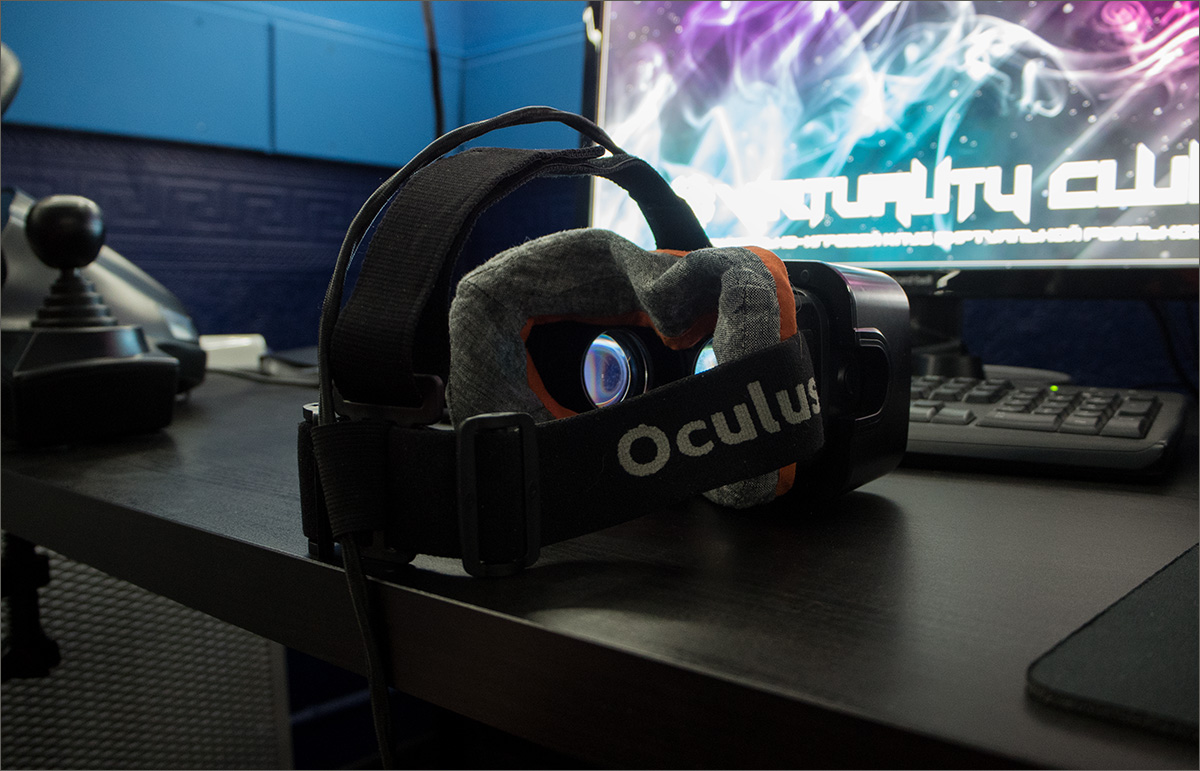
About Oculus itself told more than once, including on GT. For example, here there is an excellent translation by TheSpyMonkey , in which it is told about the estimated system requirements of the final version of the VR-helmet, and about the main problems of the current hardware.
If we briefly examine the problems that are relevant for Oculus (and, I think, the other systems that various companies managed to produce), they all boil down to three large blocks:
')
For modern toys and their engines did not imply working with VR-systems. In some places, developers post factum fasten compatibility with drivers Oculus Rift, in some places there are amateur mods and improvements. In general, optimization and sharpening for VR in current games is out of the question, we have to wait for toys that are sharpened for VR systems. This is the first problem.
The second - well, if the frame must be built for a single monitor. But for Oculus and its analogs, it is necessary to make two frames, and not identical ones, but also with different parallax / displacement, so that the effect of immersion is maximum.
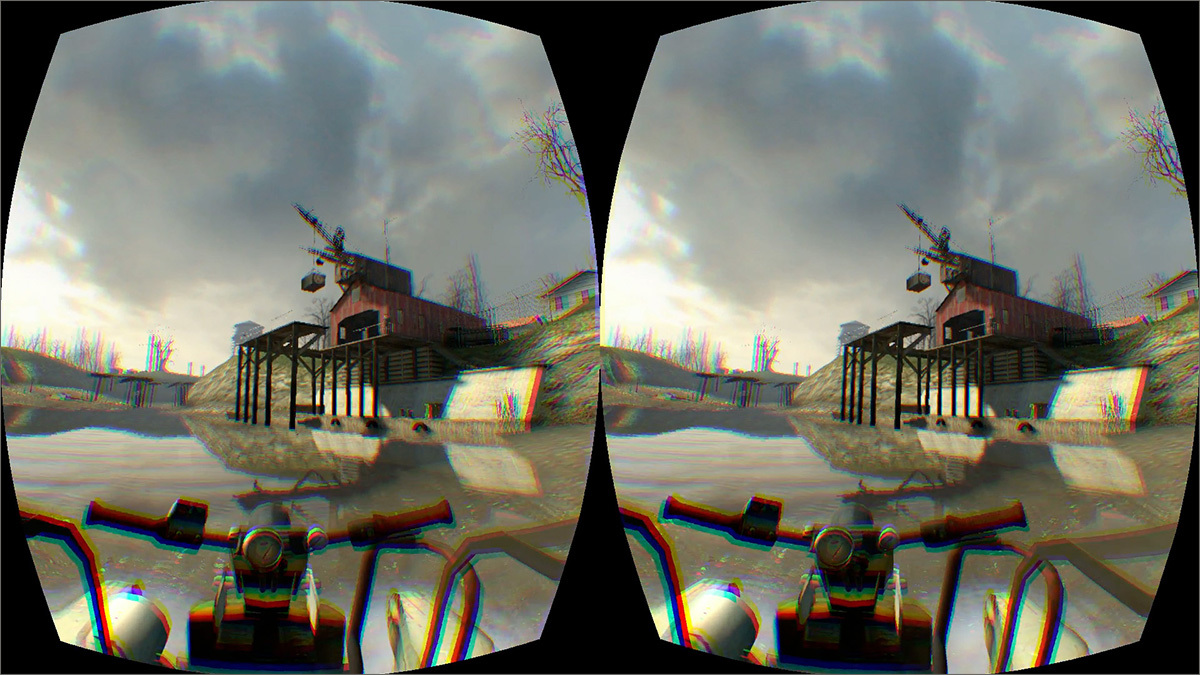
If the geometry, some shaders and other delights of constructing a three-dimensional image allow you to use the same data in memory twice, then all sorts of Z-buffers and various special effects (as well as GUI overlay) require quite serious hardware and perform all the frame calculation work twice. A video card should have good performance and a margin for ROPs (the elements that turn a 3D picture into a “flat” frame that is sent to the display) in order to draw two different frames.
Perhaps future graphics systems will be created with the expectation of the ubiquitous distribution of VR systems as game monitors, and the drivers / hardware component will be optimized for calculating two frames from one with a shift, but now these problems only increase the requirements for hardware: even if in release Oculus Rift versions will not display 2160x2160 or 1440x1440 for each eye, the video card must be taken with a margin.
Now Oculus VR calls the R9 290 and GTX 970 video cards “recommended” for DK2 (Developer Kit 2, the current version of the VR helmet), while the “eye” resolution is only 960x1080 pixels, but there are some nuances that talk a little later.
The third problem is the owners of laptops. The performance of modern mobile chips, of course, is somewhat inferior to the desktop, but remains at a fairly serious level. Their ability to drive "at medium settings" with a virtual reality helmet may well be enough, but the problem is that not all the laptops have a properly organized HDMI output. Energy-saving systems (like Nvidia Optimus, which allows you to run a voracious discrete video chip only when Intel's embedded video processor cannot provide normal performance) can become a stumbling block, because all the picture output is still run through the built-in video adapter and is sent from it to the HDMI port, and the “minimum requirements” of the RIFT include 2 USB ports of version 3.0 and HDMI 1.3c with direct output (or better, 1.4 s 3D support by native means).
As you can see, the problem is optimization, optimization and optimization again. That is, until there is a ready market for 3D helmets, there will be no normal support from software developers and hardware. And they want content to be ready and slowly finish their product. We can only wait or buy overpowered iron.
To test Oculus (the device is quite expensive to buy it "to play", besides it is the Developer Kit, and not a complete commercial product with all the consequences) I turned to friends from the first entertaining-gaming virtual reality club : I brought my 980Ti , after which we tested it for half a day on all sorts of settings.
A few words about the equipment of the club itself: now there are 4 PCs installed, three of which work with the GTX 970 (we already wrote about it in three parts: 1 , 2 , 3 ), in addition, one of them is connected to a special system with VR-assisted an armchair.

There are a lot of different toys, but the number of AAA titles is, alas, more modest. From 100% working (and working as it should) - Half-Life 2, Team Fortress 2, Live for Speed, Assetto Corsa, WarThunder, GTA 5. These toys also work well: Minecraft, Battlefield 4, Crysis 3, Borderlands 2 and Darkness 2
Some games have to be fed by a third-party driver, and the gameplay on them may look weird. However, this does not save us from the weirdness of the gameplay and with the “native” support of Oculus: for example, Half-Life 2 has separate control of the head and the “trunk”. No, it is “like in real life”, but it requires a habit. And it also has a strangely fixed camera, as a result of which it is sometimes difficult to navigate (especially from unaccustomed), and to play effectively, recalling all the shock cuts and other tricks - and this is a severe challenge.

Some games with patches come with more adequate support for the VR helmet, some, on the contrary, completely lose touch with reality, support falls off, drivers do not interact with the helmet / game (hello, Project CARS) in general, while everything is damp, but really cool Experience from VR can be obtained on what is advised in the club itself.
In most games, the GTX 970 handles high settings with no problems. But high - it does not mean the maximum. We put the GTX 980Ti, check the driver update, set the virtual 4k2k resolution and "everything to the maximum." Works. Somewhere 40 FPS, somewhere 55-60, but the incredibly powerful 980Ti can do this. Even GTA 5 with crazy settings, a virtual resolution of 2560x1440 and a third-party driver for Oculus Rift work quietly at 40 frames per second.
Well, now about the sad. There is absolutely no difference in the picture between the GTX970 and the GTX 980Ti, and now I will tell you why.
Inside Dev. Kit'a second version is AMOLED screen from Samsung Galaxy Note with a resolution of 1920x1080 pixels. He has a very high response speed, and he has a number of features that are necessary for high-quality work in VR glasses. Even Sony will have an AMOLED screen with their favorite IGZO-matrix in Project Morpheus. A spoon of tar - PenTile.
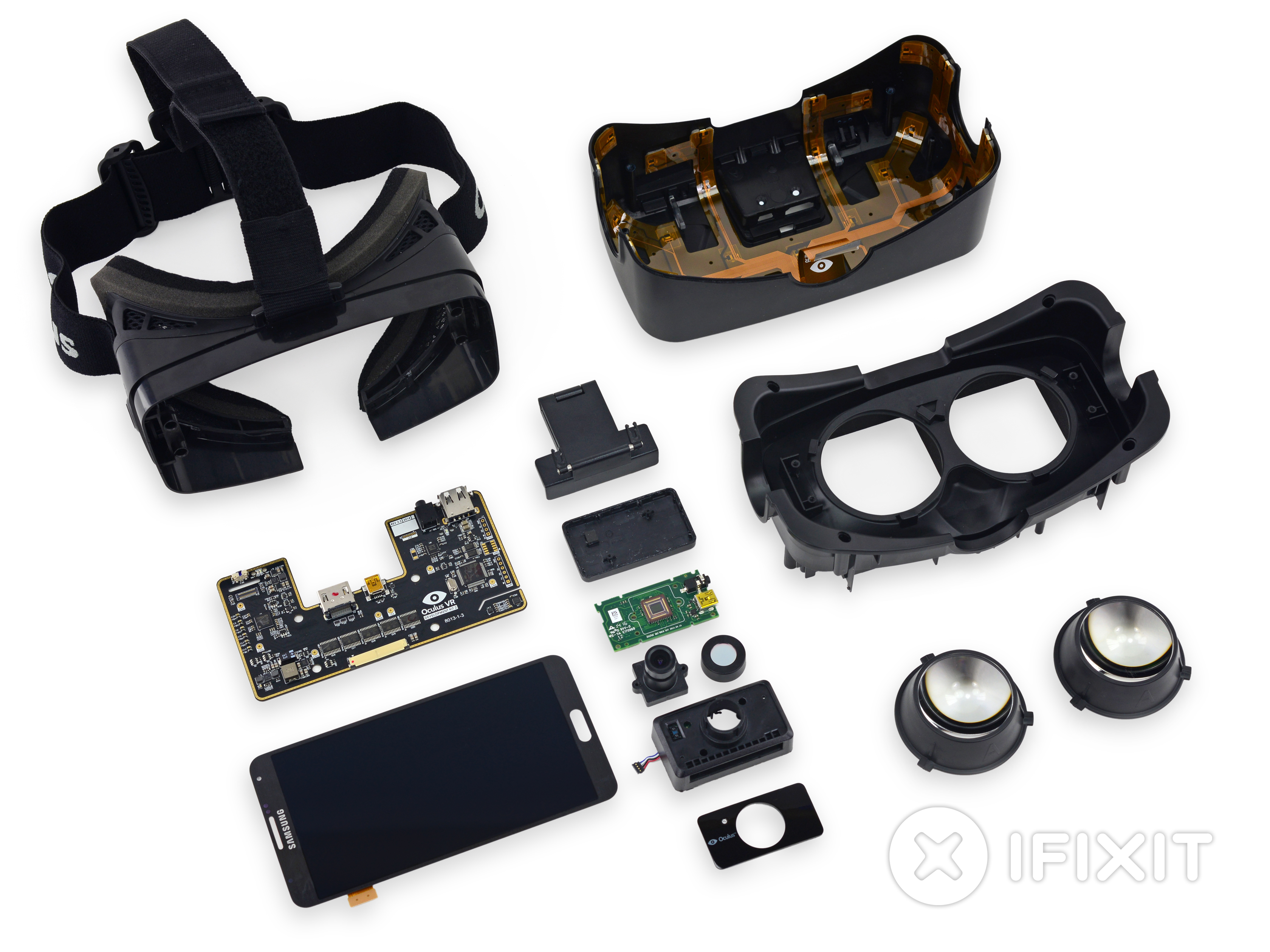
Inside, there really is a screen from Note, even the technological slits under the buttons and sensors remained.
The ill-fated “chess” arrangement of subpixels does not affect the work with the phablet or smartphone, the resolution is high, the “comb” is almost imperceptible. Here, the display is right before your eyes, and even taking into account special lenses ... let's say, the detailing of the picture is so-so. So the difference between the "maximum", "super maximum" and "absolutely indecent maximum" settings you will not see. And on the usual “high” ones, the GTX 970 will pull in. However, this low-resolution thing was promised to be corrected in the release version, that's when the GTX 980Ti comes in handy.
The version for mere mortals, not developers and enthusiasts will be released next year. They promise 1440x1440 or 2160x2160 for each eye, which in itself will increase the load on the GPU, so that the owners of the GTX 970 will only have to reduce the settings to "high" or "medium", especially those that directly affect pixel performance, ROPs (which 970 is not enough) and work with memory (the consumption of which for two “monitors” will only increase). But users of the GTX 980 and especially the GTX 980Ti will be able to feel comfortable - the “simple” version of the GTX 970 just doesn’t have these bottlenecks, and the GTX 980 Ti is a stick stick, that's all.
The video card is undoubtedly an overkill for current needs, but good as a start for 3-4 years in advance. Those who have already managed to buy it a month ago are probably glad, because the dollar did not spare the prices for this monster, I can only sympathize with the rest, now 980Ti costs about 48 thousand rubles for the simple version and about 52-54 rubles for custom , with improved cooling system and factory overclocking.
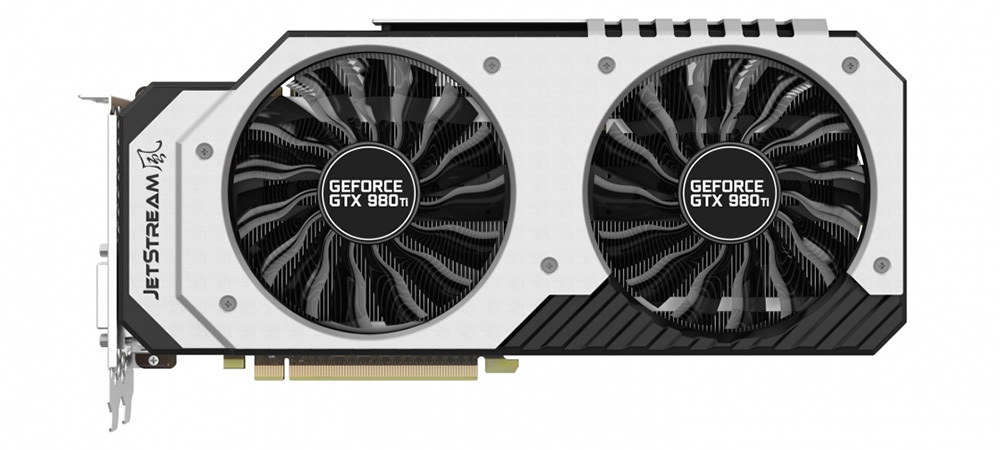
However, Radeons don't cost much less, FuryX (about which there is material too) dangles at tests on the GTX 980Ti (somewhere faster, somewhere slower), which can be attributed to raw drivers and various configs of test equipment. for different reviewers and users, moreover, it has only 4 GB of memory versus 6 for 980Ti.

R9 390X , rather, a competitor for the usual 980 and just a good card for GPGPU, with a huge memory margin (8 GB) and uncompromising FP64 performance for that money.
The most interesting thing from all that is there, of course - an interactive chair (motion simulator in virtual reality).
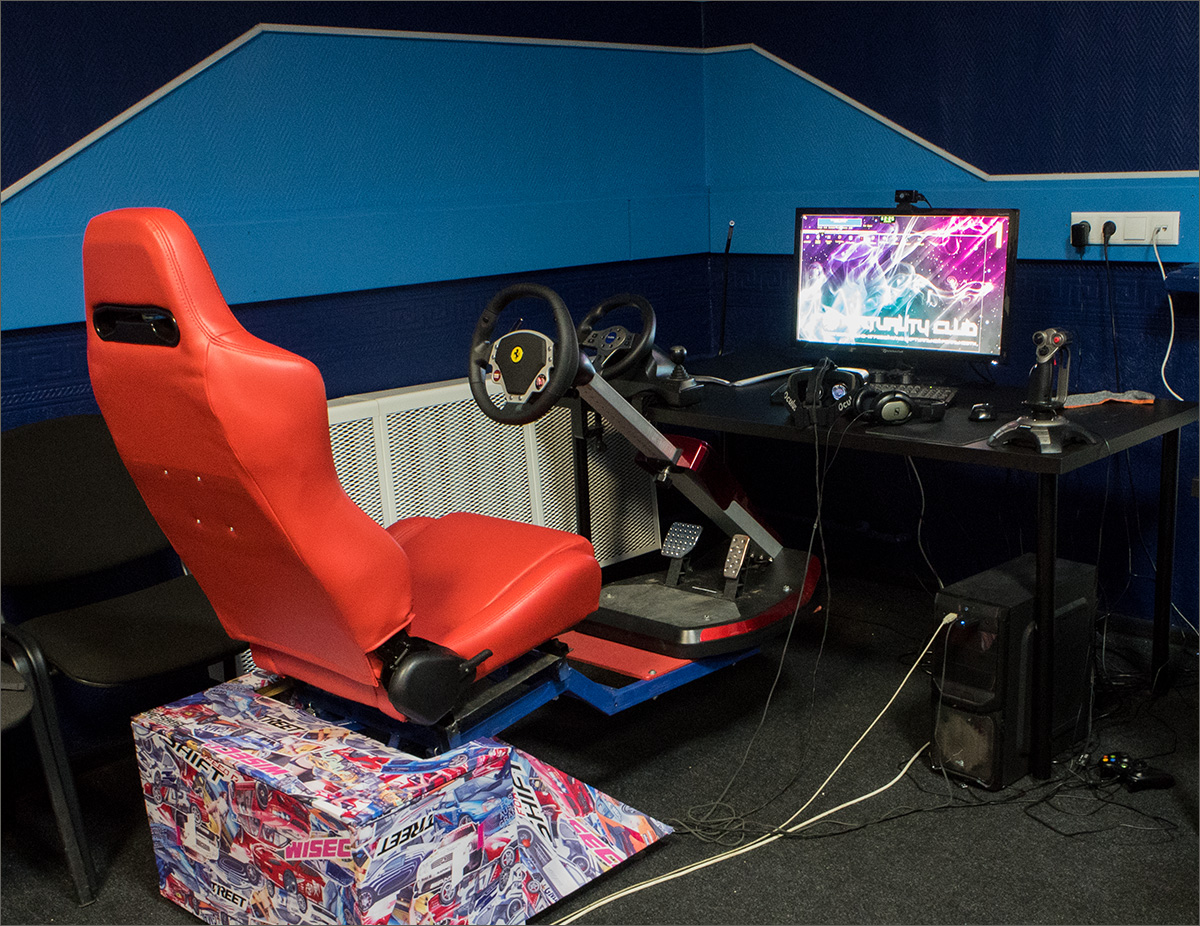
Together with Oculus, it gives an amazing sense of presence. After him, playing “just racing” or indulging in a “roller coaster” sitting on the couch is something completely different. In addition, the disorientation and motion sickness syndrome is greatly reduced with this chair.

Understandably, acceleration and deceleration (that is, overloading) cannot be transmitted, but the sensation of a car or “hanging up” in turning points of a roller coaster, a dead loop or a “barrel” gives you more than decent, and the rest is drawing your brain.
You can try anyone in Oculus Rift and this wonderful chair in Moscow can be anyone, all the phones, address addresses and passwords are on the site . Well, if you really want your own Oculus Rift, you can also buy it there. And I thank them very much for spending the day, benchmarks and fussing with the GTX 980Ti, it was worth it.
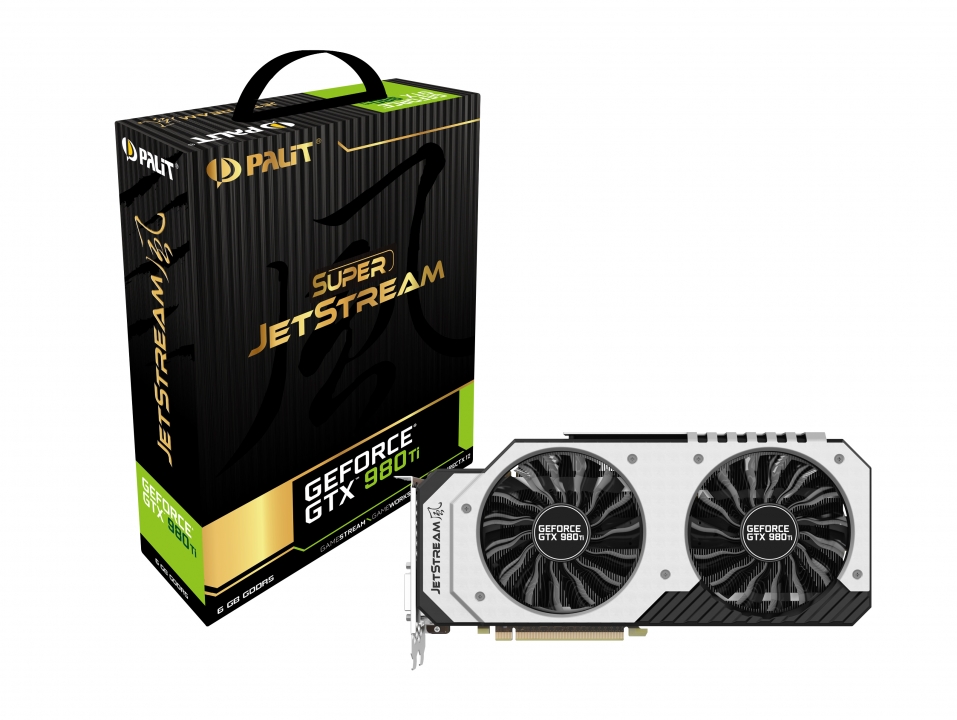

About Oculus itself told more than once, including on GT. For example, here there is an excellent translation by TheSpyMonkey , in which it is told about the estimated system requirements of the final version of the VR-helmet, and about the main problems of the current hardware.
Chicken and egg problem
If we briefly examine the problems that are relevant for Oculus (and, I think, the other systems that various companies managed to produce), they all boil down to three large blocks:
')
For modern toys and their engines did not imply working with VR-systems. In some places, developers post factum fasten compatibility with drivers Oculus Rift, in some places there are amateur mods and improvements. In general, optimization and sharpening for VR in current games is out of the question, we have to wait for toys that are sharpened for VR systems. This is the first problem.
The second - well, if the frame must be built for a single monitor. But for Oculus and its analogs, it is necessary to make two frames, and not identical ones, but also with different parallax / displacement, so that the effect of immersion is maximum.

If the geometry, some shaders and other delights of constructing a three-dimensional image allow you to use the same data in memory twice, then all sorts of Z-buffers and various special effects (as well as GUI overlay) require quite serious hardware and perform all the frame calculation work twice. A video card should have good performance and a margin for ROPs (the elements that turn a 3D picture into a “flat” frame that is sent to the display) in order to draw two different frames.
Perhaps future graphics systems will be created with the expectation of the ubiquitous distribution of VR systems as game monitors, and the drivers / hardware component will be optimized for calculating two frames from one with a shift, but now these problems only increase the requirements for hardware: even if in release Oculus Rift versions will not display 2160x2160 or 1440x1440 for each eye, the video card must be taken with a margin.
Now Oculus VR calls the R9 290 and GTX 970 video cards “recommended” for DK2 (Developer Kit 2, the current version of the VR helmet), while the “eye” resolution is only 960x1080 pixels, but there are some nuances that talk a little later.
The third problem is the owners of laptops. The performance of modern mobile chips, of course, is somewhat inferior to the desktop, but remains at a fairly serious level. Their ability to drive "at medium settings" with a virtual reality helmet may well be enough, but the problem is that not all the laptops have a properly organized HDMI output. Energy-saving systems (like Nvidia Optimus, which allows you to run a voracious discrete video chip only when Intel's embedded video processor cannot provide normal performance) can become a stumbling block, because all the picture output is still run through the built-in video adapter and is sent from it to the HDMI port, and the “minimum requirements” of the RIFT include 2 USB ports of version 3.0 and HDMI 1.3c with direct output (or better, 1.4 s 3D support by native means).
As you can see, the problem is optimization, optimization and optimization again. That is, until there is a ready market for 3D helmets, there will be no normal support from software developers and hardware. And they want content to be ready and slowly finish their product. We can only wait or buy overpowered iron.
On the performance of the Oculus Rift-system and NVidia-cards
To test Oculus (the device is quite expensive to buy it "to play", besides it is the Developer Kit, and not a complete commercial product with all the consequences) I turned to friends from the first entertaining-gaming virtual reality club : I brought my 980Ti , after which we tested it for half a day on all sorts of settings.
A few words about the equipment of the club itself: now there are 4 PCs installed, three of which work with the GTX 970 (we already wrote about it in three parts: 1 , 2 , 3 ), in addition, one of them is connected to a special system with VR-assisted an armchair.

There are a lot of different toys, but the number of AAA titles is, alas, more modest. From 100% working (and working as it should) - Half-Life 2, Team Fortress 2, Live for Speed, Assetto Corsa, WarThunder, GTA 5. These toys also work well: Minecraft, Battlefield 4, Crysis 3, Borderlands 2 and Darkness 2
Some games have to be fed by a third-party driver, and the gameplay on them may look weird. However, this does not save us from the weirdness of the gameplay and with the “native” support of Oculus: for example, Half-Life 2 has separate control of the head and the “trunk”. No, it is “like in real life”, but it requires a habit. And it also has a strangely fixed camera, as a result of which it is sometimes difficult to navigate (especially from unaccustomed), and to play effectively, recalling all the shock cuts and other tricks - and this is a severe challenge.

Some games with patches come with more adequate support for the VR helmet, some, on the contrary, completely lose touch with reality, support falls off, drivers do not interact with the helmet / game (hello, Project CARS) in general, while everything is damp, but really cool Experience from VR can be obtained on what is advised in the club itself.
In most games, the GTX 970 handles high settings with no problems. But high - it does not mean the maximum. We put the GTX 980Ti, check the driver update, set the virtual 4k2k resolution and "everything to the maximum." Works. Somewhere 40 FPS, somewhere 55-60, but the incredibly powerful 980Ti can do this. Even GTA 5 with crazy settings, a virtual resolution of 2560x1440 and a third-party driver for Oculus Rift work quietly at 40 frames per second.
Well, now about the sad. There is absolutely no difference in the picture between the GTX970 and the GTX 980Ti, and now I will tell you why.
Oculus rift dk2
Inside Dev. Kit'a second version is AMOLED screen from Samsung Galaxy Note with a resolution of 1920x1080 pixels. He has a very high response speed, and he has a number of features that are necessary for high-quality work in VR glasses. Even Sony will have an AMOLED screen with their favorite IGZO-matrix in Project Morpheus. A spoon of tar - PenTile.

Inside, there really is a screen from Note, even the technological slits under the buttons and sensors remained.
The ill-fated “chess” arrangement of subpixels does not affect the work with the phablet or smartphone, the resolution is high, the “comb” is almost imperceptible. Here, the display is right before your eyes, and even taking into account special lenses ... let's say, the detailing of the picture is so-so. So the difference between the "maximum", "super maximum" and "absolutely indecent maximum" settings you will not see. And on the usual “high” ones, the GTX 970 will pull in. However, this low-resolution thing was promised to be corrected in the release version, that's when the GTX 980Ti comes in handy.
Oculus for users
The version for mere mortals, not developers and enthusiasts will be released next year. They promise 1440x1440 or 2160x2160 for each eye, which in itself will increase the load on the GPU, so that the owners of the GTX 970 will only have to reduce the settings to "high" or "medium", especially those that directly affect pixel performance, ROPs (which 970 is not enough) and work with memory (the consumption of which for two “monitors” will only increase). But users of the GTX 980 and especially the GTX 980Ti will be able to feel comfortable - the “simple” version of the GTX 970 just doesn’t have these bottlenecks, and the GTX 980 Ti is a stick stick, that's all.
GTX 980Ti
The video card is undoubtedly an overkill for current needs, but good as a start for 3-4 years in advance. Those who have already managed to buy it a month ago are probably glad, because the dollar did not spare the prices for this monster, I can only sympathize with the rest, now 980Ti costs about 48 thousand rubles for the simple version and about 52-54 rubles for custom , with improved cooling system and factory overclocking.

However, Radeons don't cost much less, FuryX (about which there is material too) dangles at tests on the GTX 980Ti (somewhere faster, somewhere slower), which can be attributed to raw drivers and various configs of test equipment. for different reviewers and users, moreover, it has only 4 GB of memory versus 6 for 980Ti.

R9 390X , rather, a competitor for the usual 980 and just a good card for GPGPU, with a huge memory margin (8 GB) and uncompromising FP64 performance for that money.
A couple of words about the VR club
The most interesting thing from all that is there, of course - an interactive chair (motion simulator in virtual reality).

Together with Oculus, it gives an amazing sense of presence. After him, playing “just racing” or indulging in a “roller coaster” sitting on the couch is something completely different. In addition, the disorientation and motion sickness syndrome is greatly reduced with this chair.

Understandably, acceleration and deceleration (that is, overloading) cannot be transmitted, but the sensation of a car or “hanging up” in turning points of a roller coaster, a dead loop or a “barrel” gives you more than decent, and the rest is drawing your brain.
You can try anyone in Oculus Rift and this wonderful chair in Moscow can be anyone, all the phones, address addresses and passwords are on the site . Well, if you really want your own Oculus Rift, you can also buy it there. And I thank them very much for spending the day, benchmarks and fussing with the GTX 980Ti, it was worth it.

Source: https://habr.com/ru/post/366349/
All Articles